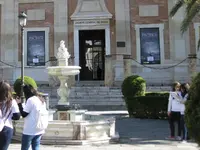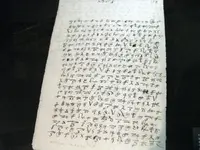Hola amigos, While I keep trying to "give up" on ever convincing Cactusjumper Joe on this topic, it occurred to me that perhaps I had failed to present an angle of this argument, which might have had some effect. So I must beg your indulgence again, thanks in advance. Joe - you have mentioned previously, that you spent decades researching this very topic, and have spoken with a number of highly respected historians about it, and this led you to conclude that there never were any Jesuit mines or treasures. Later you modified this to allow ONE mine, and now a "few" but still so insignificant as to be negligable. I have tried to point out that most modern historians, and ancient as well, are NOT interested in what any religious Order might have been doing to make money at their proselytizing missions or colonies. Historians are concerned with the facts of history, and such topics as we are discussing are very much anathema. Besides the lack of interest, there is also a level of professional, ah, well let us call it "Respect" for the Catholic Church (big C there) and a desire NOT to offend them by pointing out the rather brutal and offensive practices used by members of this same Church centuries ago. After all, any historian might well say, times were rather different than today, for instance slavery was legal and widespread, public floggings and executions commonplace and so forth. However little interest our modern historians have and have had for Jesuit mining activities, and the resulting massing of treasures/bullion, one group of experts have had such an interest, namely our experts in geology and mining. So when the USGS and Bureau of Mines, not to mention the Arizona state geology and mining agencies state that the Jesuits were the first Europeans to mine west of the Rockies, does that not carry more weight, than the historian whose main focus has been on the events and persons, wars and revolts, or the founding and destruction of cities? Why do you dismiss these experts out of hand, when they are the very type of experts whom have indeed researched in depth and on the ground at some of the old Jesuit mines as the Salero, Wandering Jew, Old Padres etc? Then it also occurred to me that you have also dismissed out of hand a string of other, otherwise highly respected sources including, <a PARTIAL listing of some of the sources posted so far in this thread> Jesuit historian Father Polzer, highly respected as an expert in the history of Arizona, cited for his recording of Jesuit rules and precepts against mining and business for profit, as well as openly admitting of two instances where Jesuit priests were caught mining and punished for it. The Royal Geographic Society, respected worldwide for their expertise The Arizona Bureau of Mines, Two Governors of Arizona Territory Jesuit Father Och, and I would point out to you that he was perfectly SAFE when he was writing his memoirs, as he was then in Europe not Sonora Jesuit Father Nentvig, whose Rudo Ensayo is one of the very few sources we have with good and fairly accurate descriptions of the settlements, mines and geography of the region as it was in the 1760's Catholic Bishop Palafox, whose letters of complaint against the Jesuits were largely supported by Pope Innocent The US Superintendant of Mining Statistics The official history of the City of Guanajuato, Mexico The internet version history of the city of Pozos, Mexico Jesuit Father Keller's letter to Father Stiger, reporting on his hiding church valuables Father Hernando de Cabrero, Visitor on keeping certain communications secret Photos of various Jesuit churches in the Americas, showing beautiful and rich ornamentation, including one with seven tons of gold The King of Spain's order expelling the Jesuits Father Provincial Francisco de Arteaga repeating the rule against Jesuits mining Father Provincial Andres Javier Garcia repeating the rule against Jesuits mining Father Alonso de Arrivillaga instructing Jesuits to burn incriminating letters and documents Thomas Edward Farish, Arizona historian The public internet site for the city of Cananea, Mexico A photo of huge furnaces for smelting of silver in Mexico built by Jesuits Author Robert Cooper West The internet page on Jesuits in the city of San Luis de la Paz, Mexico The US Bureau of Statistics, Treasury Department Mining magazine: devoted to mines, mining operations, metallurgy & c, Volume 8, 1857 Official report upon the mines, mining, metallurgy and mining laws, &c., &c ... By Henry Davis Hoskold, Argentina. Dirección General MINING AND CIVIL ENGINEER CHIEF OF THE NATIONAL OFFICES OF MINES AND GEOLOGY, reported on many Jesuit mines and included a direct translation of a Jesuit-owned mining claim document. A report written by a pirate who actually served with Captain Morgan telling of the church riches, The Buccaneers of America, in the original English translation of 1684, by John Esquemeling Father Alonso de Arrivillaga & Father Provincial Joseph de Arjo CMK Paulison, Arizona promoter and historian Auguste Carayon, S. J. Paris <Jesuit Relations, letter from Jesuit on delightful profits they are making which are in direct opposition to the rule against their trade in furs> Jesuit Father Gravier reporting on his prospecting for mines Lieutenant Sylvester Mowry, West Point grad and US Boundary Commissioner, a highly respected source I will point out Ex-jesuit Paul Hoensbroech (Graf von), for his letter of Bishop Palafox and for Jesuit wealth discovered on their arrests and expulsions in Europe Memoirs of Saint-Simon Journal of the American Geographical Society of New York Johannes Janssen, German historian Jesuit Ernest J. Burrus, editor of Ducrue's account of the Jesuits expulsion from CA Jesuit Father Baegert, for his reporting that the Jesuits were indeed accused of mining The Jesuit Relation for 1659 Sent to Reverend Father Claude Boucher, Provincial of the Province of France. reporting on the discovery of a gold vein which the Jesuits kept their lay workmen from by pretending it was "brass" which would not occur in nature that way Harper's Magazine, highly respected for their Civil War coverage The resources of Arizona: its mineral, farming, and grazing lands, towns ... By Patrick Hamilton, Arizona. Legislative Assembly 1881 The New York Times Frank S. Ingalls Report to Congress of 1906 Reports from the consuls of the United States, Issues 81-84 By United States. Bureau of Foreign Commerce, 1887 Bishop Antonio de los Reyes <ornaments in the missions as you found them after Jesuit expulsion> The hand-book to Arizona: its resources, history, towns, mines, ruins and ... By Richard Josiah Hinton 1878 New Mexico, her natural resources and attractions: By Elias Brevoort, 1874, self-published but with excellent sources listed in his preface The US Forest Service for their definition of mining Papal Bull Dominus ac Redemptor signed by Pope Clement XIV The National Park Service (holds many interesting Jesuit and Spanish colonial documents) New Advent.org a Catholic run website, historical data on Jesuit punishments for Indians Codelco Chile Corporation (a mining company which owns a former Jesuit mine in Chile) Martin Hunter, former official of the Hudson Bay Company A candid history of the Jesuits By Joseph McCabe History of the north Mexican states, Volume 1 By Hubert Howe Bancroft, Henry Lebbeus Oak, Joseph Joshua Peatfield, William Nemos Right Reverend Father Ignacio Maria de Retana,Right Reverend Father Guardian Fray, Francisco Villegas Garsina y Orosco, Royal Vicar-General of the Royal and Distinguished Jesuit Order of Saint Ignacio of Tayopa, and Jesuit of the Great Faculty of the Province of Sonora and Biscalla The history of California By Franklin Tuthill, SAN FRANCISCO HH BANCROFT & COMPANY 1866 Ecuador: its ancient and modern history, topography and natural resources ... By Charles Reginald Enock,NEW YORK 1914 History of the Jesuits: from the foundation of their society to ..., Volume 1 By Andrew Steinmetz, pp 421 PHILADELPHIA LEA AND BLANCHARD 1848 "Jesuit Saints and Blesseds" a website OF the Society of Jesus Mindat.org, an internet database of mines around the world COUNTY RESOURCE SERIES No 1 SEPT 26 1916 SANTA CRUZ COUNTY ARIZONA THE OLDEST MINING REGION OF RECORD ON THE PACIFIC OF THE UNITED STATES By Allen T Bird University of Arizona Mission Guevavi excavation by William J. Robinson, published in the KIVA, vol 42, No. 2. 1976 Luz de Tierra Incognita by Spanish Captain Juan Mateo Manje, who accompanied Father Kino on some of his explorations Jesuit Father and now Saint Eusebio Kino The Bankers' magazine, and statistical register, Volume 32 Arizona and Silver Mining, George R Gibson April 1878 Reverend Victor B. Stoner's 1937 Thesis, titled "THE SPANISH MISSIONS OF THE SANTA CRUZ VALLEY." New Handy Atlas By McNally and Co Rand, Rand McNally and Company, Chigaco and New York, 1892 Statistics of Mines and Mining in the States and Territories West of the LETTER from THE SECRETARY OF THE TREASURY by United States Dept of the Treasury, Rossiter Worthington Raymond, United States Commissioner of Mining Statistics, GEO S BOUTWELL Secretary of the Treasury 1871 Terry's Mexico: handbook for travellers, SONORA NEWS COMPANY Callé de las Estaciones 12 Mexico City Mexico T. Philip Terry, 1911 A letter from Captain Juan Bautista de Anza to Bishop Benito Crespo, January 7, 1737 Modern History being a continuation of the Universal History Volume 39 By George Sale, George Psalmanazar, Archibald Bower, George Shelvocke, John Campbell, John Swinton, London 1763 <There are quite a few more but I think this makes the point> Do you still hold all of these sources in contempt, as "repeating lies" to make it the truth, based on some "enemies" of the Jesuits? Anyone whom looked at the Jesuits cross-eyed could be interpreted as their "enemy" it seems. And Joe, despite our having cited all these sources, pointed out the Jesuit precepts against mining and yet it is documented that they had a number of mines and slaves to boot, besides the Royal orders repeatedly attempting to get ALL the religious Orders to stop mining, plus that SOME gold was found hidden in one of the Jesuit missions in Baja after the expulsion, you continue to view all those sources as "a lie repeated often enough to become the truth"? To me, it appears that you are not just "convinced" of your opinions but have chosen to be blind to any and every thing which is contrary to your belief. Do you not remember that our Jesuits have denied having ANY mines or treasures? There should not be any evidence or record of them, for this to be true. Yet even father Kino hid a treasure during the 1695 uprising, fathers Nentvig and Och describe the impressive "ornaments" including solid silver statues and candelabras etc. We know that the Jesuits had their own fleet of ships, separate from the Papal navy, what were those ships for, if not to carry their rather impressive commerce and bullion? They say that there is no anti-smoker worse than a reformed EX-smoker, and this parallels our discourse here, for you once did believe that there were Jesuit treasures, though looking in the one area where it is most unlikely (the Superstitions) and came to disbelieve, well at one time I did not believe there were any such treasures OR mines, for I reasoned, how on earth could a MINE be lost, after all? In other words you are the reformed ex-believer, and I am the reformed ex-skeptic, which makes both of us less willing to change position. The truth is there amigo, those Indians rebelled against their Spanish and Jesuit (and Franciscan) masters repeatedly and for good reason. Indians fled from the missions wholesale in California Alta, under the rule of the good Franciscan padres, and had to be rounded up and brought back as virtual prisoners in their own villages. The missions had to be self supporting - they HAD to make a profit, and the Jesuits were very energetic at finding ways for "their" Indians to be self supporting, with the padres holding the cash register of course, and set their Indians to work at plowing, planting, raising livestock, and mining - no possible source of earning income was ruled out, for anything from mining salt to trapping furs in the north country was fair game. I know we have reached the point where we are repeating things, which I admit to, which is easier than trying to find the old post and then post a link to it, and it is done to raise points and not simply for repetition; we are actually no where near the end of the available evidence concerning Jesuit mines and treasures, however when EVERY source provided, including Jesuit and Catholic studies is treated as if it were a pack of lies made up by treasure authors, I wonder if there is any reason to continue with this. I have some info which I believe would be very convincing to anyone whom might see it, but I will not post it nor share it as I intend to act upon this myself. Those treasure stories which you 'sneer' at, did not grow out of the air, in most cases such stories are based on facts. Details got garbled, sometimes exaggerated, but originated in real events and places. Otherwise where are the massive, impressive solid silver altar and ornaments of San Xavier del Bac, or those solid silver statues at EVERY dependent mission (aka visita) which have never been found? Good luck and good hunting Joe and everyone, and I can agree with you that there are almost certainly no lost Jesuit treasures or mines in the Superstition mountians. I won't say absolutely no chance of it, because of a particularly grey episode of Jesuit history, namely their attempt to convert and reduce the Apaches, which failed twice. We know some details on the second failed attempt, but almost nothing on the first, only the name of the priest. I hope you find the treasures that you seek. Roy ~ Oroblanco









